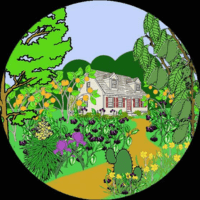Elderberry Plant Guide
Elderberry is a diverse group of plants. But, there are many similarities. We categorize Elderberries into four types: American, Blue, European, and Red.
American and European Elderberry are often called, Black Elderberry. European Elderberries (Sambucus nigra) are well known for their medicinal qualities. Red Elderberries were used extensively by Native Americans. Blue Elderberry is less-known, and grown for reasons other than human food. We describe all four types of Elderberry below. All varieties have commercial qualities.
American and European Elderberry fruit are made into syrups, jams, cordials, gummies, tinctures, capsules, powder or dried fruit, and wine. Edible Elderberry dishes and products are usually made from European varieties.
There are very ornamental varieties. Most varieties produce huge flower heads! However, they can be grown simply as a hedge, for erosion control, or in naturalized areas where suckering spread is appreciated. Elderberry produce excellent pollinator and wildlife food. Poor soil or great soil, dry or wet conditions, or full sun to dapple light, and self-pollinating. You cannot go wrong growing Elderberry.
This is a HEPPY™ plant. They need NO water once established, show NO disease and NO pests, adaptable virtually any conditions (soil, water, light), and can be pruned as needed (or, not pruned). Elderberries are about the easiest edible shrub to grow.
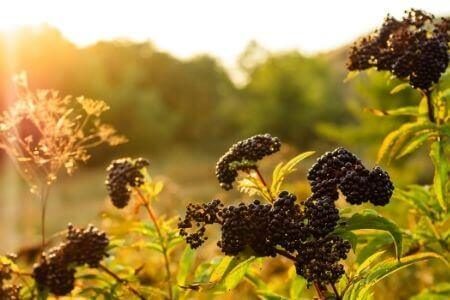
Elderberry Plant Guide on ONE ad-free webpage!
On this page:
1. Elderberry Fact Sheet
2. Types of Elderberry Plants
3. Elderberry in landscaping and garden ideas
4. Eating Elderberry
5. Elderberry health benefits
6. Commercial products & opportunities
7. How To Grow, Prune and Harvest Elderberry
8. Propagating Elderberry
9. Elderberry we grow at HEPPY™!
________________________________________
see our list of 400 edible plants
YouTube channel (please subscribe)
YouTube playlist for ELDERBERRY (please subscribe)
Elderberry Fact Sheet
common names: Black Elder, Elder, Elder Flower, Sambucus
Zone: 3 to 9 (individual types differ, eg, 5-8)
Height: 6 to 20 feet (individual types differ)
Native: yes & no (Sambucus nigra is not)
Bloom Time: May – June
Bloom Color: White or Pink
Fruit Maturity: August – September
Self-fertile: yes
Sun: full sun to part shade
Water: medium (tolerates wet soil)
Soil: forgiving
Maintenance: low
Growth Rate: medium
Deciduous or evergreen: deciduous
Edible¹: yes (see below)
Medicinal²: yes (see below)
Commercial viability: strong (discussed below)]
Family / Genus: Adoxaceae / Sambucus
Remarks: virtually the easiest edible fruiting shrub to grow; pest/disease free; tolerates poor soil and dry or moist sites; very easy to propagate (commercial qualities); trim / prune into a variety of shapes or don’t prune; large variety of plants to suit a variety of ornamental needs.
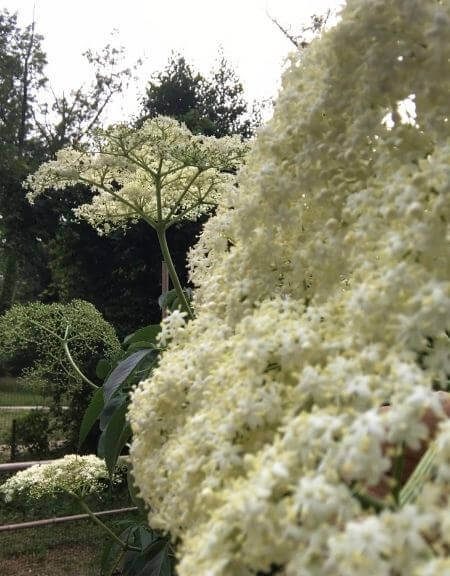
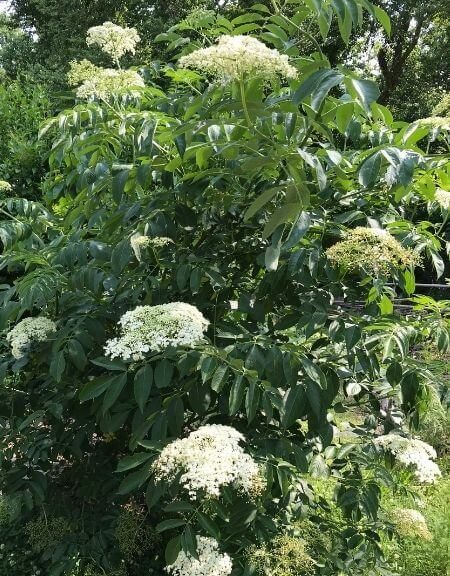
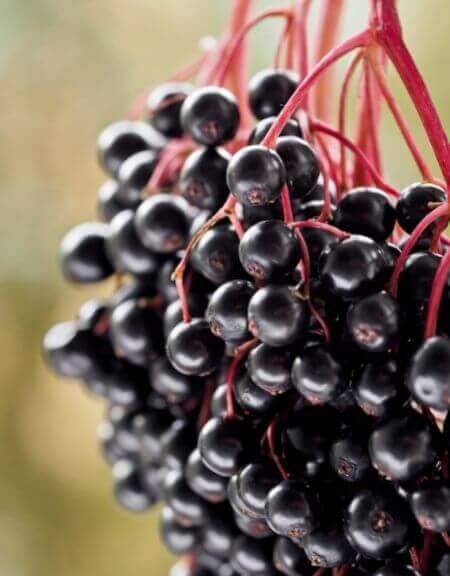
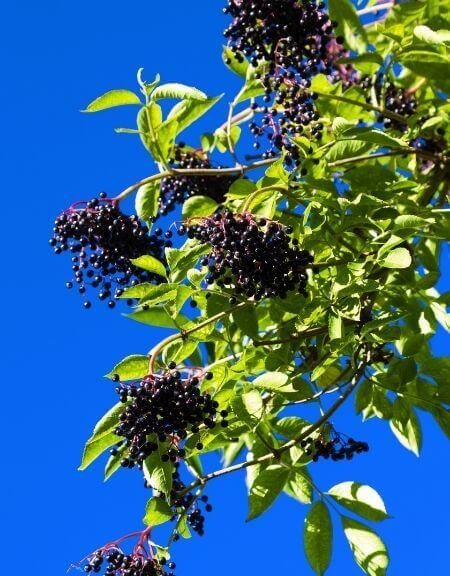


Four types of Elderberries — American, Blue, European, and Red
The Royal Horticultural Society and USDA currently lists American Elderberry as Sambucus nigra var. canadensis. We make the distinction: American Elderberry (Sambucus canadensis) and European Elderberry (Sambucus nigra).
three of four types are native to North America. all are self-fertile, grow as multi-stemmed shrubs, and are SUPER low-maintenance. it’s a showy plant; the leaves are graceful, the bloom are large, and they can produce buckets of fruit. Elderberries are very adaptable. they tolerate poor soils and thrive in rich organic soil. they grow in dry or moist sites. and they there’s a diverse variety of plants — checkout the four types of Elderberry below!
Elderberries — 4 types
American Elderberry (Sambucus canadensis)
also called the American Elder or American Black Elderberry, this species is native to North America. Sambucus canadensis is an exceptionally easy plant to grow.
approximately 50 species of songbirds, upland game birds, and small mammals eat American Elderberry fruit during summer and early fall. HOWEVER, the plant’s new growth contains a glucoside that can be fatal to livestock.
profuse and large white heads of blooms erupt in May to June. blooms give way to large heads of small berries — Elderberry fruit!
American Elderberry grows up to 12 feet. this plant grows in zone 3 to 9.
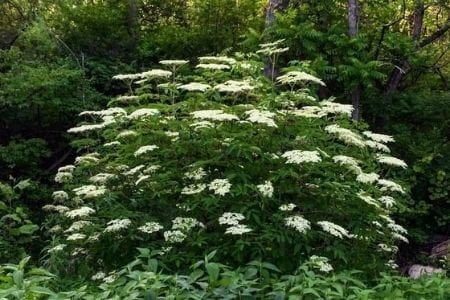
Blue Elderberry (Sambucus mexicana)
also called the Mexican Elder or Tapiro, and the species name Sambucus caerulea is also used. it’s native to North America. however, its native range is Northern Mexico to South-West America. HEPPY™ is looking to buy this plant. it isn’t easy to find for sale (opportunity ;).
what we read online is somewhat conflicting. it may grow up to 30 feet tall … or no more that 15 feet. it is self-fertile; however, the fruit is not flavorful, according to all sources. Blue Elderberry (Sambucus mexicana) appears to be more an ornamental plant or, something to propagate for sale, rather than an Elderberry to grow for food. it can handle permanently moist soil near stream sides or seeps, and will thrive next to or in regularly irrigated areas.
this plant grows in zone 4 to 9 (info online is somewhat conflicting about the zone too).
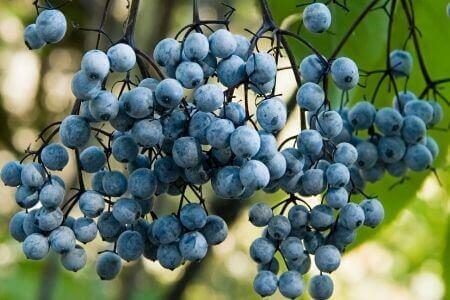
European Elderberry (Sambucus nigra)
also called the European Elder, this species is native across Europe to North Africa. you may see Sambuci fructus as a species name. Sambucus nigra is heavily cultivated and comes in MANY varieties. varieties include plants with lime-green leaves, green, light hints of purple, or dark purple/magenta colored leaves. all varieties are prolific bloomers.
Sambucus nigra is the species heavily studied in NIH / PubMed articles. on the other hand, little research is found on the American Elderberry (Sambucus canadensis). Sambucus nigra is the species used for most products that cite “Elderberry.” Syrup, gummies, tinctures, capsules, and powders — these products are usually made from European Elderberry (Sambucus nigra).
European Elderberry grows up to 20+ feet. this plant grows in zone 5 to 8.

Red Elderberry (Sambucus racemosa)
American Red Elder, Red Elder, Red-berried Elder, this species is native to North America and Eurasia.
as with the Blue Elderberry, Red Elderberry appears to be more an ornamental plant, grown for wildlife food, or something to propagate for sale. its fruit is more bitter than the American and European Elderberries. HOWEVER, while not flavorful to the pallet, it was used extensively by American Native Americans. Red Elderberry was used by the Apache, Bella, Coola, Carrier, Gitksan, Hesquiaht, Kwakiutl, Makah, and Ojibwa peoples. here’s another article on how Red Elderberry is grown and harvested. finally, here’s NIH / PubMed research on the Red Elderberry.
Red Elderberry grows up to 12 feet. this plant grows in zone 3 to 7 (she grows in Canada!).

Elderberry in landscaping and garden ideas
Elderberries are inexpensive, and come in a LARGE variety of colors. it’s about the easiest edible plant to grow. they tolerate full sun or shade. Elderberries fit ANY landscape idea and garden.
Landscape Architecture
in landscape architecture, Elderberries are an excellent sprawling hedge. tolerant of many soils, levels of sun and water, they are also vey easy to maintain.
Elderberries are used as an ornamental hedge, single accent plant, for fruit production, or for pollinators. they are suitable for erosion control, as a green screen (but are deciduous), backgrounds, and stream or pond peripheries.
it is an attractive plant with luscious, powerful shoots that develop into leaved canes. cultivars are very diverse. some have lime-green leaves, green, light hints of purple, or dark purple/magenta colored leaves.
flower-heads can be huge — at least 10 inches across. Elderflowers are pink or white; some cultivars’ flowers have a lemony smell but most have a light sweet smell.
VERY little pruning is needed, if at all. however, they tolerate heavy pruning if need-be. it fits in any backyard and front yard landscaping design.
Elderberries is an excellent, reliable and VERY low-maintenance fruiting shrub. they WILL fit your in landscape architecture.
Garden Ideas
Elderberries are about the easiest plant to grow. huge heads of flowers (Johns) give way to large clusters of fruit. Elderberries are versatile and productive.
they grow most compact in full sun; find a sunny location if you want optimal flowering & fruit. we see NO disease or pest. NO chemical sprays are needed to grow Elderberries.
Elderberries are adaptable to dry, medium or wet conditions. HEPPY™ grows our ‘girls’ in rich organic soil, and do not water them. and, they tolerate a variety of sunlight. however, flower & fruit production decreases in shady locations.
highly adaptability, easy-to-grow with excellent commercial properties — include Elderberries in your garden ideas!
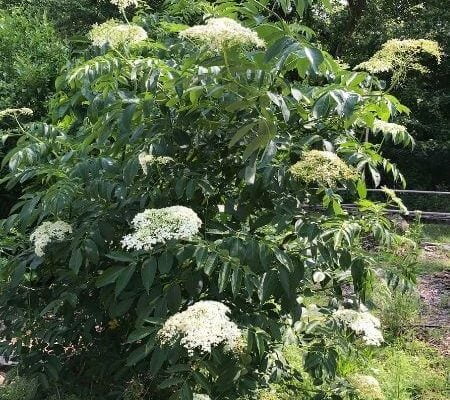
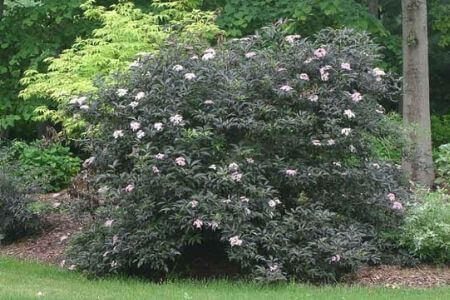
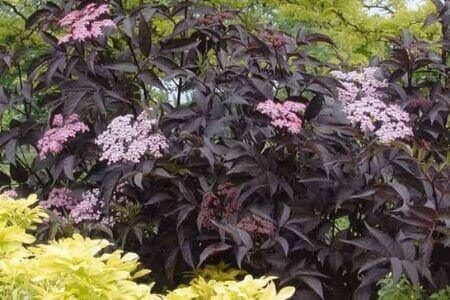
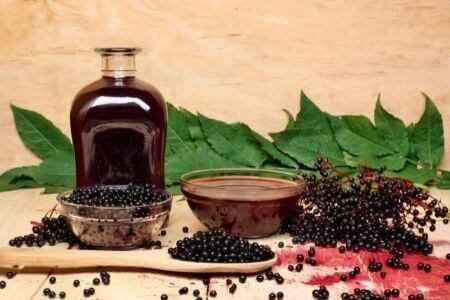
How To Eat Elderberry Fruit
1, 2 HEPPY cannot take any responsibility for any adverse effects from the use of plants. Always seek advice from a professional before using a plant for food or medicinally. This information is intended for educational purposes only and should not be considered as a recommendation or an endorsement of any particular medical or health treatment.
Edible fruit
Black Elderberry is grown for fruit. “Black” Elderberry are the European Elderberry (Sambucus nigra) and American Elderberry (Sambucus canadensis) species. European Elderberries are most commonly grown for fruit, followed by American varieties. HEPPY™ recommends cooking fully ripe elderberries. we have eaten moderate amounts of raw, fully ripe fruit and had no issues. harvest Elderberry fruit when they’re deep, dark purple and the skin is getting a bit dull. more about harvesting Elderberry is below.
Elderberries can be made into syrups, jams, pie, cordials, tinctures, powder or dried fruit, and wine. harvesting the fruit is tricky. “de-stemming” the fruit is the trick. it’s done best when the fruit is freshly picked. more about harvesting Elderberry fruit is below.
CAUTION: it’s safest to use and cook only the ripe fruit, and do not eat any other part of the plant.
1. the NIH writes, “Raw unripe Elderberries…contain toxic substances (e.g., sambunigrin) that can cause nausea, vomiting, and diarrhea; cooking eliminates this toxin. Large quantities of the toxin may cause serious illness.”
2. leaves, stems, bark, and branches are, or may be, poisonous (Launert. E. Edible and Medicinal Plants, & Cooper. M. and Johnson. A. Poisonous Plants in Britain and their Effects on Animals and Man).
3. these folks made Elderberry Juice with wild berries, leaves and branches. their severity of illness correlated with the amount of elderberry juice consumed; those who drank only tea remained well. the hospitalized person had consumed five glasses of the juice. do NOT eat leaves and branches, we recommend.
Recipes
Midwest Elderberry Cooperative is a trusted source to buy Elderberries.
Norm’s Farms posts MANY Elderberry recipes. all ad-free recipes!!! (OMG, ad-free ;). Elderberry in drinks, for breakfast, Elderberry appetizers, in main dishes, side dishes, condiments, and desserts!
here’s a recipe for Elderflower Cream Pie with Blueberries and Elderberries! or, make Elderberry Gummies. how about a recipe for Black Bean Elderberry Chipotle Dip!!
Elderberry Syrup
How to Make Black Elderberry Syrup from Fresh Elderberries, thanks to Norm’s Farm:
3 cups cleaned and destemmed black elderberries
1 cup water
2 tablespoon raw unfiltered honey
1 tsp freshly squeezed lemon juice
Optional flavorings: 1/8 to ¼ tsp grated fresh ginger, ¼ tsp ground cinnamon, pinch of cloves, dash of vanilla extract.
1. Place 3 cups ripe, clean and destemmed black elderberries in a medium saucepan, cover with one cup of water and place on low heat on the stove.
2. Cover the pan and simmer on low for about 30 minutes.
3. Periodically check the color and the taste of the liquid surrounding the berries. You want to achieve a deep purple color and a strong berry taste. CAUTION: Don’t simmer the berries too long! Doing so will create a bitter taste.
4. Strain the berries and liquid through a fine mesh sieve into a bowl. Use the back of wooden or stainless-steel spoon to mash the berries against the side of the sieve to extract any remaining juice.
5. Immediately add the honey and lemon juice and any of the optional flavorings, stir to combine.
6. Add more honey if you prefer a sweeter taste.
7. Ladle the black elderberry syrup into sterilized canning jars and seal tightly.
8. To preserve your homemade elderberry syrup, place each sealed canning jar into a large canning pot, cover with water, and bring to a boil.
9. Allow the jars to boil for 10 minutes.
10. Remove the jars using canning tongs from the hot water bath and place on a rack or towel to fully cool and complete the sealing process.
This recipe yields one cup of homemade Black Elderberry Syrup. While your homemade Black Elderberry Syrup is cooling you should hear the familiar “ting” of the caps being drawn down by the vacuum created during the canning process. Once the jars are fully cooled, check each lid to be sure that it is sucked down tight. If you find any that are questionable, place them immediately in the fridge or re-can them. Properly canned homemade black elderberry syrup will store in your pantry for quite some time, at least a year. Once opened, store your homemade black elderberry syrup in the fridge. Thank you to Norm’s Farm.
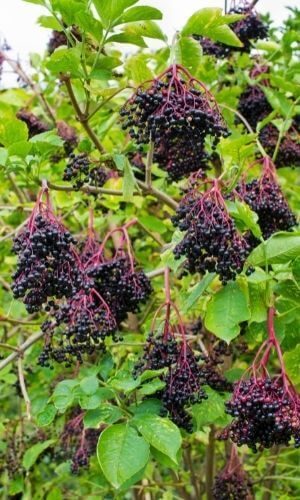

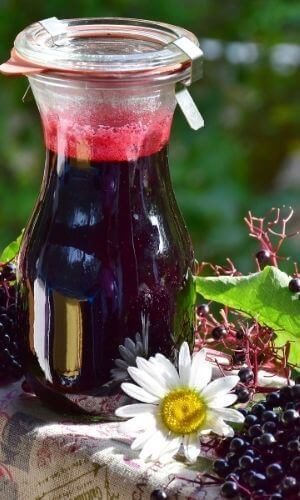
Elderberry Health Benefits
1, 2 HEPPY cannot take any responsibility for any adverse effects from the use of plants. Always seek advice from a professional before using a plant for food or medicinally. This information is intended for educational purposes only and should not be considered as a recommendation or an endorsement of any particular medical or health treatment.
note that almost all NIH and European research is on the European Elderberry (Sambucus nigra). for example, search NIH PubMed for American Elderberry, “Sambucus canadensis”. unfortunately, there’s virtually no study on Sambucus canadensis!
for the European Elderberry (Sambucus nigra): Numerous studies indicate that Elderberry fruit and flowers of are highly nutritious and rich in bioactive compounds such as polyphenols and anthocyanins. consequently, elderberry is characterized by high antioxidant activity, which significantly affects its health-promoting properties. studies have shown that elderberry has mainly antibacterial and antiviral properties, can reduce sugar and lipid concentration, and even exhibit antidepressant and antitumour properties.
Polyphenols are the most important group of bioactive compounds present in Elderberry in relatively high concentration. Polyphenols are known for their free radical scavenging (antioxidant) activity. Elderberry is rich in nutrients, such as carbohydrates, proteins, fats, fatty acids, organic acids, minerals, vitamins and essential oils. however, Elderberry also contains cyanogenic glycosides which are potentially toxic [cooking eliminates this toxin from Elderberry fruit]. NIH / PubMed, Bioactive properties of Sambucus nigra L. as a functional ingredient for food and pharmaceutical industry (2018).
HEPPY™ is a no bullsh&% entity. we perform A LOT of research for many plants. we use PubMed, and then corroborate research with other trusted sources (eg., Harvard Medical). i’ve performed training for biostatistics, and maria is a medical doctor. we are not experts but we can muddle our way through medical research. having said that, we conclude that there is no definitive research showing Elderberry to be a ‘wonder’ cure. research studies are few and with small number of participants. respectfully, this is a failure of the research community. ONE research paper is published by firm/s that performs, “Claim Substantiation.” that means that their goal is to find the result you want.
HOWEVER, Elderberry does — with certainty — is rich in bioactive compounds such as polyphenols and anthocyanins, has antioxidants and antiviral properties, and can reduce sugar and lipid concentration (regulating diabetes).
Elderberry Health Benefits in medical research
these are excerpts from three trusted studies:
- Sambucus nigra are highly nutritious and rich in bioactive compounds such as polyphenols and anthocyanins. Thanks to these compounds, elderberry is characterized by high antioxidant activity….It was shown that elderberry has mainly antibacterial and antiviral properties, can reduce sugar and lipid concentration, and even exhibit antidepressant and antitumour properties. NIH / PubMed, Bioactive properties of Sambucus nigra L. as a functional ingredient for food and pharmaceutical industry (2018).
- a significant effect of elderberry on cold duration and cold associated symptoms was detected. Travellers using elderberry from 10 days before travel until 4–5 days after arriving overseas on average experienced a 2-day shorter duration of the cold and also noticed a reduction in cold symptoms. MDPI, “Elderberry Supplementation Reduces Cold Duration and Symptoms in Air-Travellers: A Randomized, Double-Blind Placebo-Controlled Clinical Trial” (2016).
*** HEPPY™ note: This ONE randomized, double-blind placebo-controlled clinical trial of 312 economy class passengers travelling from Australia to an overseas destination. - Natural polyphenols extracted from S. nigra [Elderberry] and A. melanocarpa [Chokeberry] modulate specific and non-specific immune defenses in insulin-deficiency [Type 2] diabetes and reduce the inflammatory status and self-sustained pancreatic insulitis [ie, it is good to reduce inflammation and the risk of insulitis]. NIH / PubMed, Effects of Sambucus nigra and Aronia melanocarpa extracts on immune system disorders within diabetes mellitus (2015).
Unusual research claims
we found research cited that is unusual. be VERY careful when reading claims. here are two examples of unusual claims:
- Claim 1: this study is cited for Elderberry’s effect on respiratory infections, “Black elderberry (Sambucus nigra) supplementation effectively treats upper respiratory symptoms: A meta-analysis of randomized, controlled clinical trials”.
- HEPPY™ comment: there three flags.
1. there is no disclosure of the clinical trials examined (the basis for the meta analysis).
2. we cannot find the full report. we find only the Abstract. the fully reports discloses methodology, tables, evaluation criteria, etc. the Abstract’s ONE key sentence, “Supplementation with elderberry was found to substantially reduce upper respiratory symptoms.” is not supported.
3. The Franklin Institute of Wellness is the research lab that conducted this research. here’s the report on the researcher’s webpage and on NIH/PubMed. - performed a study on Black elderberry (Sambucus nigra) supplementation effectively treats upper respiratory symptoms: A meta-analysis of randomized, controlled clinical trials. “Protect your bottom line with health claim substantiation.” they serve to substantiate claims (“Protect your bottom line with health claim substantiation“). I’m sure that their service has value. however, there appears to be a conflict of interest.
***************************************************************
- Claim 2: “Elderberries (Sambuci fructus) [European Elderberry] have been shown in a number of studies to have significant anti-inflammatory and antioxidant effects. Multiple human and animal studies have supported the anti-inflammatory and antioxidant effects of elderberry preparations and it has been used in natural medicine for hundreds of years.”
- HEPPY™ comment: this claim is made in a clinical trial that’s posted online (ClinicalTrials.gov Identifier: NCT02414607). the trial is to study “Effect of Elderberry Juice on Cognition and Inflammation in Patients With Mild Cognitive Impairment.” it does not cite the research behind the claims.
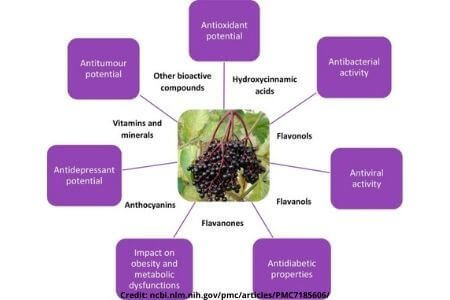
Sell Elderberry Products — Commercial Qualities of the Elderberry
Elderberry ranked as the 18th best-selling herbal dietary supplement on the medicine, food and mass market in the USA in 2011 (Engels & Brinckmann, 2013). PubMed, “Bioactive properties of Sambucus nigra L. as a functional ingredient for food and pharmaceutical industry” (2018). a lot of marketing has been done for YOU!
Elderberry products include “seeds, cuttings, plants in pots, fresh and frozen elderberries, dried flowers, wine, juice, concentrate, extract, syrup, jelly, jam, food colorants, vinegar, fudge, barbeque sauces, salad dressing, carbonated beverages, cordials, juice blends, yogurt and pie.” (University of Missouri Center for Agroforestry, Growing and Marketing Elderberries in Missouri (2012)).
Farmers' market or cottage food industry
Elderberry syrup is a common product. making tinctures and tea are easy at-home products. Elderflowers can be harvested too. Elderflowers are harvested for fresh use or drying are clipped when all flowers are open. flowers are easily removed by rubbing flower-clusters over screens. Elderflowers may then be dried or frozen for future use.
Jam, jelly and preserves is an excellent Farmers’ Market or cottage food product. Elderberry jam is made with only a few ingredients: Elderberries, water, lemon juice, pectin, and a sweetener such as honey. or, make Elderberry chutney, vinegar, barbeque sauce, or cordials.
one gallon plants sell for $5.00 – $20.00. selling fresh berries depends on the who is buying the fruit (a winery vs. supplemental manufacturer). also, where are you selling at — in a urban city’s Farmers’ Market or in a rural area? harvesting the fruit is a bit tedious — more about harvesting Elderberry is below.
Elderberry is also used as a food coloring and in body lotions. finally, about 95% of Elderberry used in the USA is imported from Europe.
Commercial or private landscaping
HUGE heads of white spring blooms. Leaves with colors that range from lime-green, green, hints of purple, to dark purple/magenta. tolerate poor soil and wet or dry conditions.
prune an Elderberry in any form or fashion. most varieties do perfect with the most minimal pruning (ie, pruning-away a dead stem or two). however, prune annually if you want to maximize flowering / fruit production.
uhmmmm, how does the Elderberry NOT fit into commercial or private landscaping!
How To Grow Elderberry: Grow, Prune and Harvest
Elderberry plants grow in dry and moist soil, and comes in many colorful varieties. huge blooms, and we have no disease or pests. Elderberry are the easiest fruiting shrub to grow and maintain.
Growing Elderberry
Elderberry thrive in full or partial sunny locations. like almost all fruiting plants, the more sun the plant gets the more blooms it produces and the more fruit. but, it also depends on why you’re growing Elderberry. it’s such a diverse plant. it’s equally easy to grow Elderberries in a more shady location for ornamental reasons, from erosion control, etc.
determine your purpose for growing Elderberry.
for seed, propagation, flower, or fruit production: plant Elderberry in as much sunlight as possible. plant her in rich organic soil (if you have very poor or hard soil, then create a bed above it). water plants that are less than 3 years old; once established, we do not water our Elderberries so we have less pruning.
for ornamental or other purposes: Elderberry need partial sunlight and little else.
CAUTION: USDA states that, “New growth of American elder [Sambucus canadensis] contains a glucoside than can be fatal to livestock.” to be safe, I would assume all species of Elderberry (Blue, European and Red) have glucoside, and are potentially fatal to livestock.
Pruning
the need to prune Elderberry is dependent on why you’re growing Elderberry. prune very little, if grown for ornamental reasons; prune heavily if grown for fruit. it’s best to prune in January and February.
for fruiting Elderberry, un-pruned Elderberry plants will produce an acceptable fruit crop. on the other end of the spectrum, commercial farmers prune Elderberry to the ground. they prune Elderberries flush to the ground so that they’ll re-grow from the root system. aggressive pruning has several benefits: fewer but larger & more productive canes; fruit will ripen more uniformly; and it removes any over-wintering insect eggs, pests, and disease.
for ornamental Elderberry, prune away dead, diseased or damaged stems. for slightly greater management, remove most of 3-year-old and older wood if you’d like to stimulate new growth / larger heads of flowers. cut-back weak canes to strong wood and, shape the Elderberry plant. prune-away tip grow to promote a fuller plant.
Harvesting
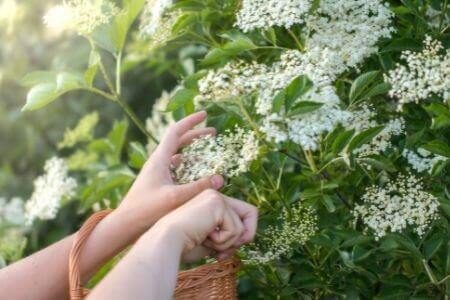
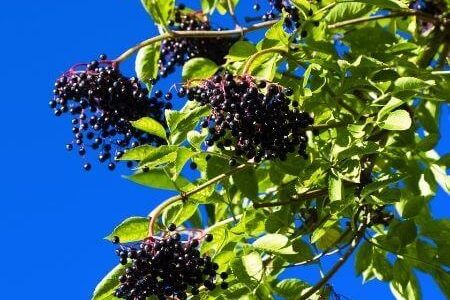
Elderberry flowers and fruit grow on “cymes.” i call them ‘clusters’ on this webpage. cymes or clusters — it’s beautiful large heads of flowers & fruit.
Picking Elderberry
flowers give-way to small green berries. then, berries slowly darken to a shinny purple color and then, the berries become dull-dark-purple. HARVEST Elderberry cymes when most individual berries become dull-dark-purple. note that individual berries — on a cyme — do not ripen evenly. simply harvest berries when become dull-dark-purple. (the Bob Gordon cultivar is known for ripening more uniformly; for fruit production, they are pruned to the ground annually.)
De-stemming Elderberry
de-stemming Elderberry fruit is the next process. it’s best to de-stem within 24 hours of picking cymes. stem-less fruit is important because stems alter the flavor.
there are professional de-stemming machines and DIY methods. use stainless steel products if you’re selling fruit to the public.
one effective DIY method is to freeze the cymes with the fruit on it. once frozen, the fruit separates easier from stems (and the fragile little berries stay whole).
Freezing Elderberry
freeze fruit within 24 hours. professional growers set freezers at 20F. they allow air around storage containers to assure thorough freezing.
Propagating Elderberry: cuttings, division, grafting, layering and seeding
Elderberry root cuttings or rooting dormant hardwood is exceptionally easy. Softwood cuttings and propagating from seed is possible. propagating by seed has mixed results. seedlings vary in yield, fruit quality and plant performance.
Elderberry Propagation: root, hardwood and simple layering
harvest hardwood or root cuttings in late February / early March. take cuttings before before growth starts.
root propagation: Elderberry plants will sucker. root propagate by gently digging up 3-6 inches of root — a section of root that has roots and green growth. simply plant in airy potting soil (soil high in perlite, vermiculate, rotted woodchips, etc.). here’s a vid of us doing that.
a note about suckering: some varieties sucker ‘gently’ — they do NOT spread quickly. some varieties sucker a lot. it could be individual plants vs. varieties that have the ‘suckering tenancy,’ btw. for example, our Johns has grown no more than 5 suckers in 3 years growing within 24 inches of the plant’s base. our Bob Gordon suckered like NUTS!
hardwood propagation: 1-year wood is best. that’s last year’s growth (assuming you’re harvesting hardwood in the winter). we propagate hardwood cuttings by simply placing cuttings into rotted woodchips. the bedding of rotted woodchips is in a shady location (dappled shade). we experimented by setting full canes — pruned in winter. the canes sent shoots out by late spring / early summer. we have all the Elderberry plants we can handle :/
Elderberry growing at HEPPY™
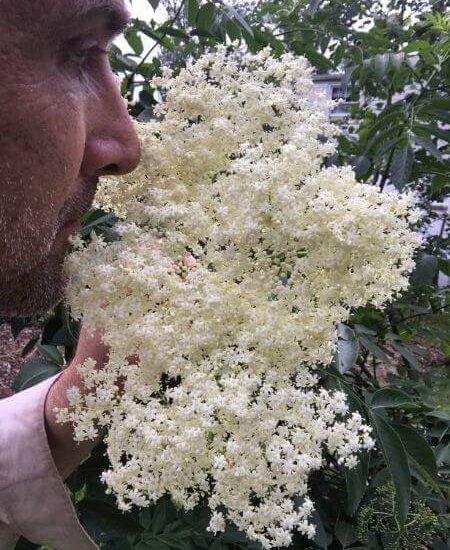
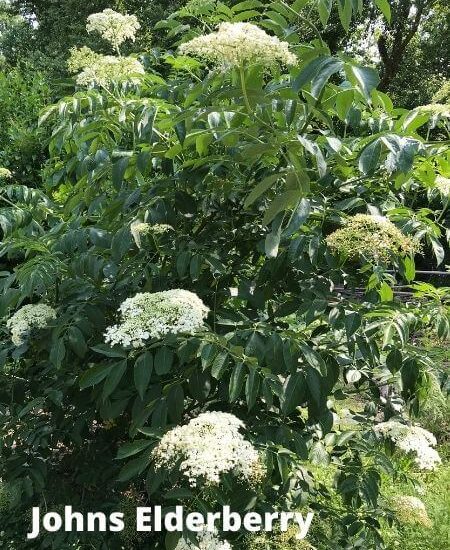

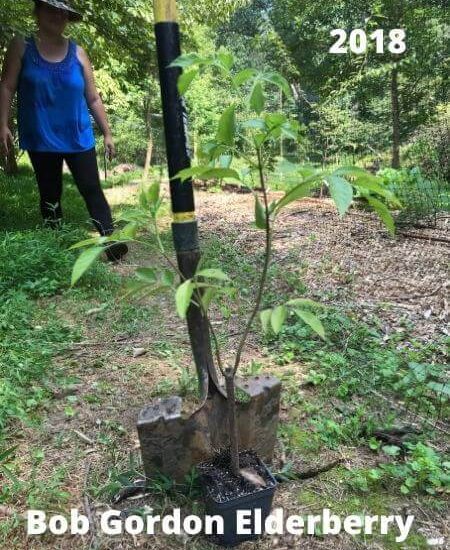
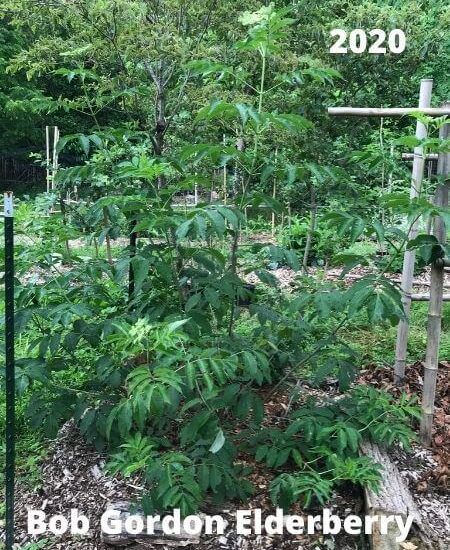
Elderberry for food
Johns and Bob Gordon Elderberries are grown for food.
Johns Elderberry produces LARGE clusters of medium to large sized berries. it fruits earlier than other varieties and is an excellent choice for berry production. our Johns grows very erect. it was released in 1954 from Kentville Research Station, Nova Scotia.
Bob Gordon Elderberry is known for production! the Bob Gordon produces larger and juicer berries. It is the leading juice variety. current commercial cultivation is to cut to the ground in the winter and flowers and fruit are formed new canes, producing the same season. our Bob Gordon grows like a shrub, more than erect. this variety was first discovered in the wild near Osceola, Missouri. it was released in 2011 from the University of Missouri/Missouri State University.
the Johns Elderberry was purchased as a 1 gallon plant for $20.00 (from Edible Landscaping). it grew very fast and we’ve propagated many plants from her.
the Bob Gordon was purchased as a little 4 inch pot for $15.00 (from Peaceful Heritage Permaculture Fruit Nursery). she also grew fast and large.
our Elderberry show NO disease or pests. and pruning dead branches is rare.
now, in year 3, we will likely prune the Bob Gordon to the ground. it’s huge, and has grown as a large bush. we’ll propagate the cuttings. subscribe to our YouTube Channel and follow along!
Ornamental Elderberry
we purchased a Blue, Black Lace and Red Elderberry in early 2022! they arrived to HEPPY at the time of this writing! i’m sooooo excited!
one Blue Elderberry will be planted along our stream bank. we will use her to mitigate stream erosion. and we’re planning a collage of Elder by planting a Blue, Red and Black (Johns) together!
the Black Lace is very ornamental and will be placed in a strategic location for the ‘wow’ factor!
also, we look forward to growing other ornamental European Elderberry. varieties such as the Black Beauty and Cut Leaf Elderberry plants have exceptional ornamental value.
subscribe to our youtube channel and follow our progress in growing the Black lace Elderberry plant!
References
Missouri Botanical Garden:
American Elderberry (Sambucus canadensis) | European Elderberry (Sambucus nigra) | Red Elderberry (Sambucus racemosa)
Plants for a Future:
American (Sambucus canadensis) | Blue (Sambucus mexicana) | European (Sambucus nigra) | Red (Sambucus racemosa)
USDA PLANTS Database:
American (Sambucus canadensis) | Blue (Sambucus cerulea [syn., Sambucus mexicana]) | European (Sambucus nigra) | Red (Sambucus racemosa)
